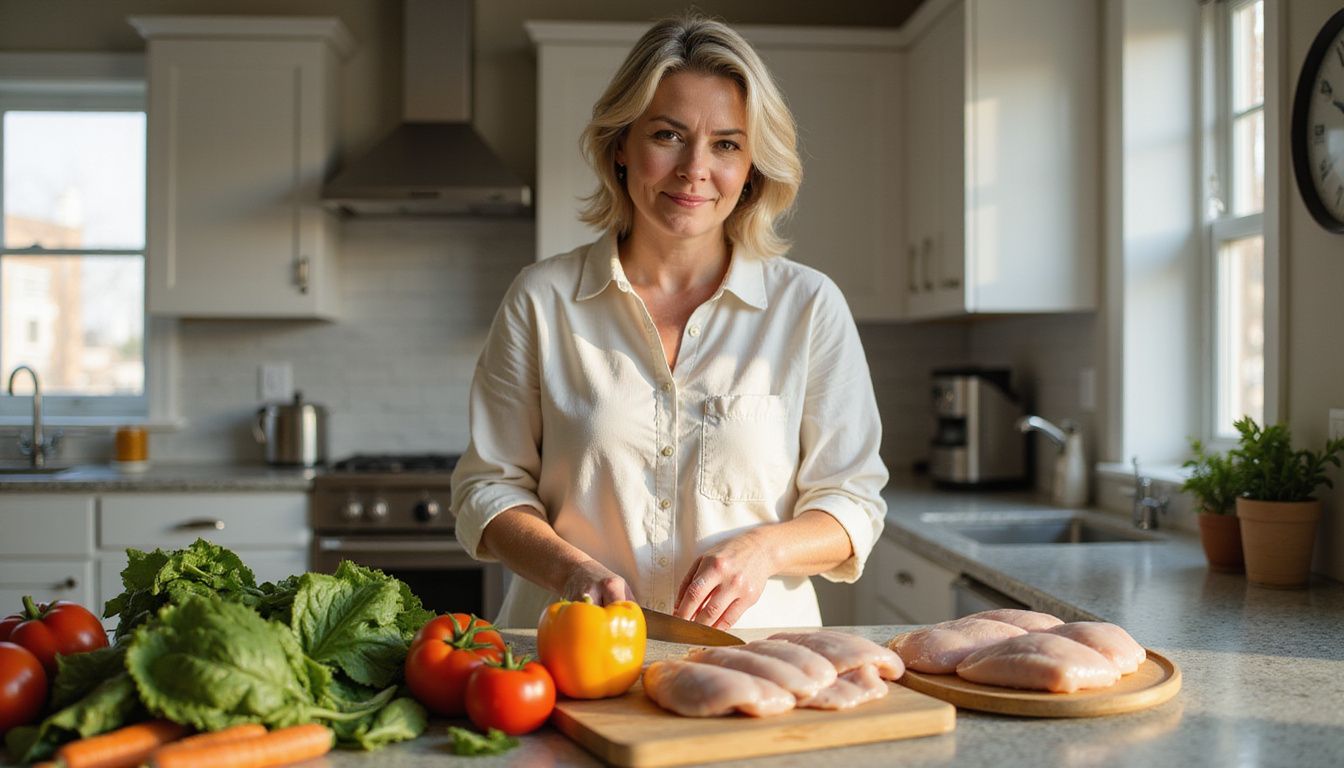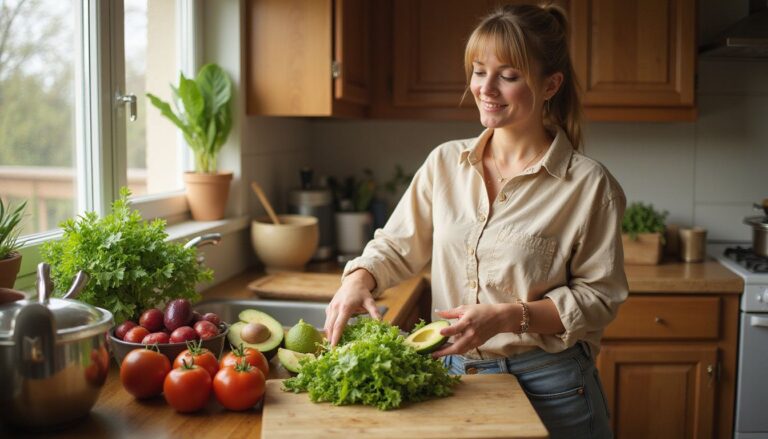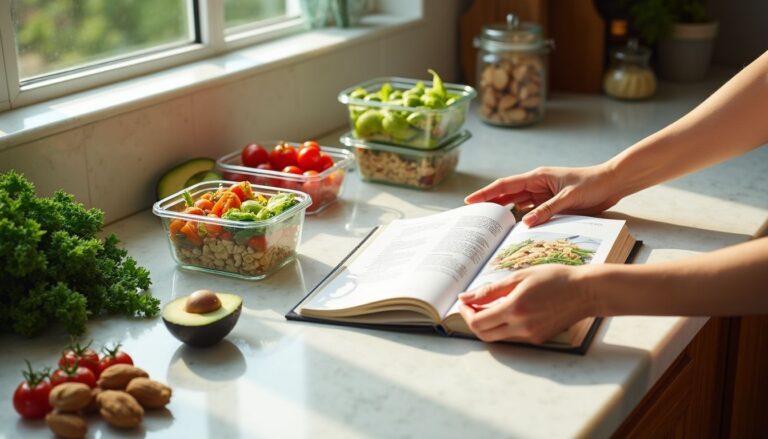Effective Meal Plan To Lose Belly Fat
Our Nutrition Assistant AI Suite will transform your body. You will lose fat, get toned, and build muscle. Gain confidence and optimal health.
Belly fat can feel stubborn, and that is frustrating. The good news is that you can lose belly fat with a smart meal plan and steady habits. This guide shares evidence-based steps from registered dietitians, plus a simple plan you can start today.
Visceral fat is the deeper fat around your organs. It raises the risk for heart disease and type 2 diabetes. A structured weight loss plan that favors protein, fiber, and whole grains helps shrink your waist while protecting health.
Key Takeaways
- Excess visceral fat raises the risk of heart disease, type 2 diabetes, and some cancers, as noted in a 2022 Journal of Aging Research review.
- Higher protein and fiber with controlled calories supports safe loss of about 1 to 2 pounds per week.
- Protein foods like grilled chicken, Greek yogurt, salmon, tofu, and eggs help reduce abdominal fat and preserve muscle.
- Choosing whole grains over refined grains relates to a lower risk of abdominal obesity, including a 17 percent lower risk seen in Framingham data.
- Regular meal prep plus daily activity improves results, in line with Department of Health and Human Services guidance.
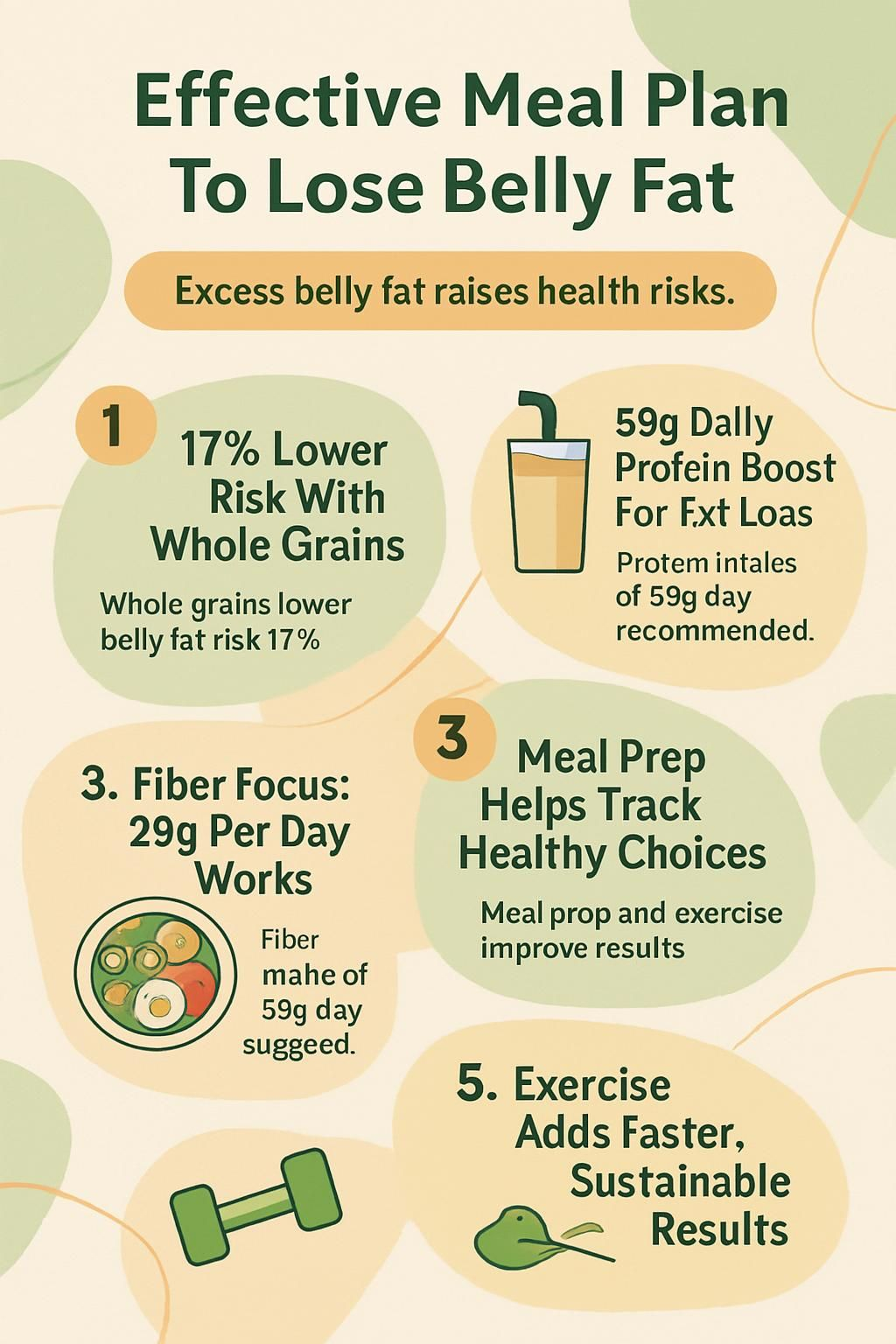
Understanding Different Types and Causes of Belly Fat
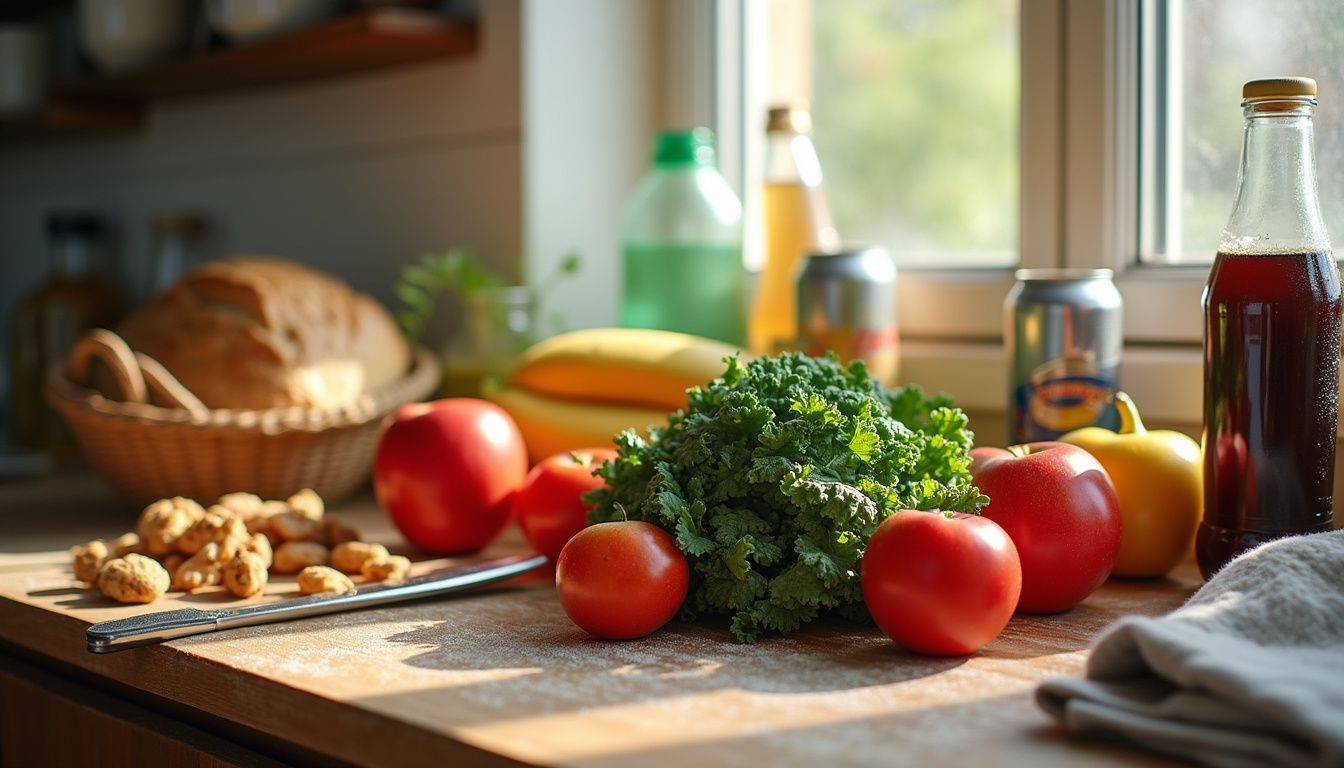
Belly fat is not all the same. Knowing the differences helps you choose the best steps to trim your waist and protect your health.
What are the differences between subcutaneous and visceral belly fat?
Subcutaneous fat sits under the skin. You can pinch it. Visceral fat sits deep in the abdomen and wraps around organs like your liver and intestines. It is more harmful than the surface layer.
Research links high visceral fat with type 2 diabetes, heart disease, and higher mortality risk in older adults. This deeper fat often responds faster to healthy eating and activity than the surface layer.
As you improve your diet and move more, your waist may shrink first. That signals a drop in visceral fat. Health agencies encourage nutrient-dense foods and regular activity to lower this risk and support a healthy weight.
What causes belly fat to accumulate?
Several habits push the body to store extra fat around the midsection. High sugar intake from soda, juice, and sweets is a common driver. Refined grains and processed snacks add to the problem by spiking blood sugar and hunger.
Stress raises cortisol, a hormone that can increase abdominal fat storage. Poor sleep has a similar effect and may lead to weight gain over time. Alcohol intake also connects with higher visceral fat.
Low physical activity slows metabolism and makes weight loss harder. Skipping meals or crash dieting can backfire, leading to overeating later.
One small change can help a lot. For example, swapping white bread for whole grain toast and adding a lean protein like turkey can steady blood sugar and reduce cravings.
How Does Diet Affect Belly Fat?
Your daily choices shape your waistline. Balanced meals control calories, support fullness, and guide your body to burn more fat instead of storing it.
How do calories and nutrients influence belly fat?
Eating more calories than you burn leads to fat storage, especially around the belly. Sugary foods and saturated fats make this worse. A plan with higher protein, more fiber, and sensible calories supports steady loss.
Many adults do well at 1,200 to 1,500 calories per day, depending on size, age, and activity. Aim for at least 58 grams of protein and about 29 grams of fiber daily. Protein from Greek yogurt, eggs, fish, tofu, or poultry supports muscle. Fiber from oats, beans, fruits, vegetables, and whole grains boosts fullness and improves gut health.
Small swaps matter. Replacing sugary cereal with oatmeal and fruit can reduce cravings within two weeks.
Why are balanced meals important for losing belly fat?
Balanced meals combine lean protein, healthy fats, and high-fiber carbs. This combo steadies blood sugar and hunger hormones. You feel full longer, so you eat fewer calories without feeling deprived.
Studies suggest high-protein meals with fiber rich vegetables help trim abdominal fat while preserving muscle. Whole grains, strained yogurt, legumes, and leafy greens also supply key vitamins and minerals.
Meals built this way help your body lose fat, not muscle. They also lower the chance of nutrient gaps and help maintain progress over time.
Key Components of an Effective Meal Plan
Build your plan around protein, fiber, healthy fats, and low-glycemic carbs. This supports digestion, muscle, and steady energy while you work toward a healthier waist.
Which high-protein foods help reduce belly fat?
- Grilled chicken breast gives about 25 to 30 grams of protein per serving and supports muscle during weight loss.
- Salmon provides high-quality protein plus omega 3 fats that protect the heart.
- Greek yogurt offers 15 to 20 grams of protein per cup. Dairy proteins like whey are linked to less abdominal fat.
- Tofu supplies plant protein at about 10 grams per half cup and works well in quick stir fries.
- Eggs have about 6 grams of protein each and support muscle retention during a 30 day meal plan.
- Low fat cottage cheese reaches up to 28 grams of protein per cup and keeps you full.
- Shrimp packs around 18 grams of lean protein in a 3 ounce serving.
- Turkey breast, skinless, gives roughly 26 grams of protein per 3 ounces with very little saturated fat.
- Beans like black beans deliver both fiber and 14 to 16 grams of plant protein per cup.
- Nuts and seeds add protein, healthy fats, and minerals. Almonds and chia seeds are great snack options.
Use these foods across the day. Try nut butter on whole grain toast, a hard boiled egg, or a Greek yogurt parfait with berries.
What are the best fiber-rich ingredients for belly fat loss?
- Lentils provide about 8 grams of soluble fiber per cooked cup. Each 10 gram bump in soluble fiber is linked with less belly fat gain over five years.
- Black beans deliver about 8 grams of fiber per half cup. Great in salads, tacos, or bowls.
- Quinoa gives about 5 grams of fiber per cooked cup and includes complete protein.
- Oatmeal offers roughly 4 grams of fiber per half cup dry and helps curb morning cravings.
- Chia seeds supply about 10 grams of fiber per ounce. Add to smoothies or yogurt.
- Sweet potatoes provide around 3.8 grams of fiber per medium potato and taste great baked.
- Raspberries pack about 8 grams per cup. Apples add close to 4 grams each for easy snacks.
- Chickpeas give about 6 grams of fiber per half cup cooked and roast well for crunchy snacks.
Simple upgrades work. Stir chia into yogurt or add a black bean salad to lunch to improve fullness and steady energy.
How do healthy fats support belly fat reduction?
- Nuts, seeds, avocado, and olive oil add flavor and help control hunger. People who eat nuts regularly often have smaller waist sizes.
- Omega 3 fats from salmon and similar fish two to three times per week may help lower visceral fat. Algae based supplements can support plant based diets.
- Replace trans fats and excess saturated fats with olive oil, nuts, or avocado to support a healthier metabolism.
- Healthy fats make salads, grain bowls, and yogurt bowls more satisfying, which reduces snacking later.
- Meals in this plan lean on healthy fat sources such as grilled salmon, roasted vegetables with olive oil, and yogurt with berries and nuts.
- Key nutrients in nuts and seeds may calm inflammation that relates to belly fat. A small handful of almonds or half an avocado at lunch can reduce later cravings.
Why choose low-glycemic carbohydrates?
- Low glycemic carbs, like quinoa, wild rice, brown rice, and oatmeal, steady blood sugar and reduce insulin spikes that store fat.
- These foods boost satiety, which helps prevent overeating at night.
- Several studies report greater visceral fat loss with low glycemic choices compared with high glycemic foods.
- Whole grains beat refined options for fiber and nutrients. Framingham data linked more whole grains with a 17 percent lower risk of excess abdominal fat.
- Fruits like oranges, apples, and berries offer natural sweetness without the heavy sugar load found in juice.
- Low glycemic vegetables such as leafy greens and broccoli help limit rapid blood sugar swings.
- Stable blood sugar can reduce inflammation linked to visceral fat and support heart health.
7-Day Meal Plan to Lose Belly Fat
This 7 day meal plan focuses on lean protein, fiber, and whole grains. It keeps sodium and added sugars in check and supports steady, realistic weight loss.
Day 1:
Day 1 is built around high protein and high fiber choices that support fullness without excess calories.
- Breakfast: Muffin Tin Omelets with feta and peppers for a protein rich start.
- One medium orange for vitamin C and hydration.
- 8 ounces green tea for a light caffeine lift and antioxidants.
- Snack: 1 cup low fat kefir, 1 cup raspberries, and 2 teaspoons chia seeds.
- Lunch: Whole wheat veggie wrap with fresh vegetables.
- Snack: Chile lime peanuts for plant protein and crunch.
- Dinner: Two cups baked vegetable soup, one whole wheat pita, and half cup hummus.
- Daily target: about 1,480 calories, 62 grams protein, 41 grams fiber, and moderate sodium.
- Keep carbohydrates reasonable and choose whole ingredients first.
Ready for Day 2. The same pattern continues, with smart swaps and simple meals.
Breakfast: Greek yogurt with berries and granola
Greek yogurt brings high quality protein that keeps you full. Berries add fiber and antioxidants for gut health. A small sprinkle of whole grain granola gives crunch and slow digesting carbs.
This breakfast lands under 300 calories and provides about 4 to 6 grams of fiber. A cup of green tea pairs well for a light, steady morning.
Lunch: Grilled chicken salad with mixed greens
A grilled chicken salad offers lean protein and plenty of produce. Mixed greens provide fiber and micronutrients that support metabolism and steady energy.
Each serving can reach 8 to 13 grams of fiber with the right mix of vegetables. Add sliced orange segments if you enjoy a sweet, vitamin C rich topping.
Dinner: Grilled salmon with quinoa and steamed broccoli
Salmon supplies protein and omega 3 fats. Quinoa and broccoli add fiber and low glycemic carbs for lasting fullness.
Keep the meal within 410 to 605 calories, depending on your needs. A small fruit on the side adds vitamins without excess sugar.
Day 2:
Day 2 balances animal and plant proteins and leans into vegetables for fiber and volume.
- Breakfast: Spinach and mushroom omelet for protein, iron, and antioxidants.
- Lunch: Whole grain wrap with lean turkey and avocado for fiber and healthy fats under 500 calories.
- Dinner: Stir fried tofu with vegetables over brown rice for a plant forward finish.
- Snacks: An orange or a small handful of nuts to manage hunger without overshooting daily fat or sodium goals.
- Vegetables at every meal to raise fiber and fullness.
- Moderate sodium to help limit water retention.
- Choose water as your main drink to cut empty calories.
- Planning your meals reduces food temptations and keeps energy steady.
This pattern supports abdominal fat loss through nutrition science and consistency.
Breakfast: Spinach and mushroom omelet
Eggs provide steady protein to carry you through the morning. Spinach and mushrooms contribute fiber, vitamins, and minerals.
This breakfast can stay under 300 calories and reheats well for busy days.
Lunch: Whole grain wrap with lean turkey and avocado
Whole grain wraps add fiber that supports digestion and fullness. Turkey keeps protein high while avocado brings healthy fats and potassium.
Aim for at least 8 grams of fiber in this meal. Add fresh spinach or tomato slices for more crunch and nutrients.
Dinner: Stir-fried tofu with vegetables and brown rice
Tofu supplies plant protein and a tender texture. A mix of colorful vegetables adds fiber and antioxidants. Brown rice offers steady energy overnight.
A typical serving runs 410 to 605 calories and promotes fullness until morning. Studies suggest high fiber dinners support visceral fat loss over time.[1]
…
Day 3:
Day 3 highlights high fiber and high protein meals that keep you full and energized.
- Breakfast: Oatmeal with almond butter and banana for long lasting energy.
- Lunch: Lentil soup with mixed greens for plant protein and fiber.
- Dinner: Baked chicken breast, sweet potatoes, and asparagus for a balanced, under 500 calorie plate.
- Snacks: Fruit or a small handful of nuts to stay on track.
- Keep sodium modest and choose simple seasonings.
- Balance protein, fiber, and healthy fats at each meal.
- High fiber foods support a healthy gut and stable blood sugar.
- Whole ingredients reduce cravings and help control calories.
This approach targets visceral fat while supporting everyday wellness.
Breakfast: Oatmeal with almond butter and bananas
Oats supply complex carbs and beta glucan fiber for steady blood sugar. Almond butter adds healthy fats and protein. Banana slices bring potassium and gentle sweetness.
This meal stays under 300 calories and can be prepped in advance for busy mornings.
Lunch: Lentil soup with a side of mixed greens
Lentils are rich in protein and fiber, which increase fullness for hours. A side salad adds variety, crunch, and extra vitamins like A and K.
Batch cooking lentil soup on Sunday makes weekday lunches fast and consistent.
Dinner: Baked chicken breast with sweet potatoes and asparagus
Chicken supplies lean protein for muscle support. Sweet potatoes deliver fiber and carotenoids. Asparagus is low in calories and high in fiber for added volume.
Cooking at home lets you manage salt and fat. The low glycemic carbs help avoid late night cravings.
Day 4:
Day 4 builds simple meals that stay nutrient dense and satisfying without heavy calories.
- Breakfast: Spinach, chia seed, and almond milk smoothie for a fast, fiber rich start.
- Lunch: Quinoa salad with chickpeas and vegetables for protein and complex carbs.
- Dinner: Grilled shrimp with zucchini noodles for lean protein and low carb volume.
- Snacks: Kefir, fruit, or nuts to fill gaps without overdoing calories.
- Dietitians reviewed these meals for balance and satiety.
Breakfast: Smoothie with spinach, chia seeds, and almond milk
Blend spinach for vitamins, chia for fiber and omega 3s, and unsweetened almond milk for a light base. This combo supports gut health and hunger control.
At about 245 calories per serving, it is easy to prep and easy to drink on the go.
Lunch: Quinoa salad with chickpeas and fresh veggies
Quinoa brings complete protein and fiber. Chickpeas raise protein and add creaminess. Fresh vegetables add color, crunch, and antioxidants.
Portion this salad into containers for three days. It keeps well and makes healthy eating simple.
Dinner: Grilled shrimp with zucchini noodles
Shrimp offers lean protein with very little saturated fat. Zucchini noodles give volume with few calories and help keep blood sugar steady.
Grill shrimp in advance and spiralize zucchini for quick assembly on busy nights.
Day 5:
Day 5 keeps the focus on fiber, protein, and healthy fats to tame hunger and support steady fat loss.
- Breakfast: Whole grain toast with avocado and poached eggs for a balanced start.
- Lunch: Grilled salmon with roasted vegetables for omega 3s and fiber.
- Dinner: Turkey meatballs with spaghetti squash to reduce refined carbs.
- Snacks: Fruit, nuts, or kefir to curb cravings and support gut health.
- Use smaller plates and pre portion meals to manage calories.
- Batch cook proteins and grains so weeknights stay easy.
- Keep salt moderate to avoid water retention.
Planning ahead keeps you aligned with your goals even on hectic days.
Breakfast: Whole grain toast with avocado and poached eggs
Whole grain toast delivers fiber for steady energy. Avocado adds healthy fats and more fiber. Poached eggs bring protein that supports muscle.
This meal lands under 300 calories with about 4 to 6 grams of fiber. It also reheats well for a quick weekday option.
Lunch: Grilled salmon with a side of roasted vegetables
Salmon offers protein and omega 3s that support heart and brain health. Roasted vegetables provide fiber and antioxidants for fewer afternoon cravings.
Preparing several servings on one sheet pan saves time and keeps your lunch on track.
Dinner: Turkey meatballs with spaghetti squash
Turkey is lower in saturated fat than beef and supports a leaner plate. Spaghetti squash replaces pasta with a high fiber, low carb option.
Make a double batch of meatballs for easy leftovers. This swap can reduce late night snacking.
Day 6:
Day 6 maintains variety, with plenty of vegetables and lean proteins to support a healthy metabolism.
- Breakfast: Matcha latte with Everything Bagel Avocado Toast, about 296 calories with 6 grams of fiber.
- Snack: Cottage cheese topped with fruit and nuts for protein and healthy fats.
- Lunch: White bean and veggie salad, about 360 calories with 13 grams of fiber.
- Add roasted vegetables for extra vitamins and minerals.
- Snack: Cut vegetables or a small handful of almonds.
- Dinner: Hot honey grilled shrimp with brown rice and steamed broccoli, about 465 calories.
- Daily total lands near 1,455 calories with roughly 70 grams protein and 29 grams fiber.
- Dietitians confirm this intake aligns with safe weight loss for many adults.
Prep proteins and vegetables in batches to make healthy choices almost automatic.
Breakfast: Cottage cheese with fresh fruit and nuts
Cottage cheese supplies lean protein to protect muscle while you lose fat. Fruit and nuts add fiber and heart healthy fats that improve fullness.
Meals like this help you approach a daily goal of about 58 grams of protein and 29 grams of fiber.
Lunch: Grilled chicken and roasted vegetable bowl
Grilled chicken provides steady protein. Roasted vegetables add flavor, fiber, and volume for few calories.
Cook several chicken breasts and a sheet pan of vegetables on Sunday to speed up weekday lunches.
Dinner: Baked cod with wild rice and green beans
Cod is a lean fish that fits well in a calorie conscious dinner. Wild rice delivers fiber and a nutty taste. Green beans bring crunch and extra fiber.
This plate helps you meet nutrition goals without added sugars or heavy fats.
Day 7:
Day 7 finishes the week with satisfying meals that keep you on track and ready for the next week.
- Breakfast: Muffin Tin Omelets with feta and peppers, plus a medium orange and hot green tea.
- Daily total near 1,510 calories supports a calorie deficit for many adults.
- Protein reaches about 84 grams to help maintain muscle mass.
- Carbohydrates land near 174 grams to fuel the day without excess.
- Fiber is around 40 grams to support gut health and fullness.
- Lean proteins, colorful produce, and healthy fats keep meals satisfying.
- Dietitians reviewed this plan for safety and balance.
- Prep a Spinach and Artichoke Salad for quick weekday lunches.
- Use a grocery list to save time and reduce food waste.
These meals are simple to repeat or mix and match for another week.
Breakfast: Veggie-packed egg muffins
Egg muffins deliver protein in a portable form. Peppers and greens add color, fiber, and vitamins.
Bake a batch on Sunday. Each muffin is about 90 calories with roughly 6 grams of protein, which makes mornings stress free.
Lunch: Black bean and quinoa salad
Black beans provide protein and fiber. Quinoa adds complete protein and slow carbs to prevent energy dips.
Prepping several servings at once makes weekday lunches quick and helps prevent unplanned snacking.
Dinner: Lean steak with roasted Brussels sprouts
Lean steak supports muscle and satiety. Brussels sprouts add fiber and complex carbs for fullness with few calories.
Roast the sprouts with olive oil and garlic for extra flavor without heavy sauces.
How Can You Prepare and Plan Meals Effectively?
Planning turns good intentions into daily wins. A little structure makes healthy eating feel simple and repeatable.
What are the benefits of batch cooking for the week?
Batch cooking saves time and reduces stress. Cooking once for several meals improves portion control and helps you stick with your calorie goals.
Pre portioned meals make it easier to include protein, fiber rich carbs, produce, and healthy fats. Buying in bulk often lowers cost and cuts waste.
How can portion control help with belly fat loss?
Portion control keeps total calories in the right range. A daily plan around 1,500 calories suits many adults, though needs vary by body size and activity.
Protein and fiber help you feel satisfied with smaller portions. Meal prep supports consistent serving sizes and reduces grazing.
Mindful eating, such as slowing down and checking your hunger, also improves weight management and supports belly fat reduction.1
What are some healthy snack ideas?
Smart snacks tame cravings and protect your calorie budget. Stock a few go to choices so you are ready when hunger hits.
- Greek yogurt with berries for protein, probiotics, and antioxidants.
- Carrot or bell pepper sticks with hummus for fiber and plant protein.
- A small handful of mixed nuts for healthy fats and minerals, about 1 ounce.
- Hard boiled eggs for portable protein.
- Cottage cheese with pineapple or peaches for protein and calcium.
- Air popped popcorn, three cups for about 4 grams of fiber and fewer than 100 calories.
- Smoothie with spinach, frozen fruit, chia seeds, and unsweetened almond milk.
- Apple slices with 1 tablespoon peanut butter for fiber plus healthy fats.
- Roasted chickpeas with spices for a crunchy, fiber rich bite.
Prepping snacks ahead lowers the chance of grabbing processed foods after a busy day.
What Foods Should You Avoid to Reduce Belly Fat?
A few foods make belly fat loss much harder. Limiting them creates faster progress and fewer cravings.
Why avoid sugary beverages?
Sugary drinks, including soda and sweetened juice, add calories without fullness. A single can of soda has about 39 grams of sugar and roughly 150 calories.
High sugar intake relates to a greater risk of type 2 diabetes and heart disease. Swapping in water, unsweetened tea, or black coffee supports your plan and helps control appetite.
What are the risks of refined carbohydrates?
Refined carbs like white bread and pastries digest quickly and often spark hunger soon after. They are lower in fiber and nutrients, which can affect blood sugar control and fullness.
Eating more whole grains, oats, and beans tends to improve energy and reduce cravings. Many people notice more stable afternoons after switching from refined to whole grain choices.
How do trans fats and processed foods affect belly fat?
Trans fats raise inflammation and are linked with larger waistlines even at similar calories. Many packaged snacks, baked goods, and fried items contain these harmful fats along with refined carbs and added sugars.
Reading labels and choosing whole foods can reduce bloat and support steady fat loss. Many people feel better within weeks after cutting these items.
What Lifestyle Tips Support Belly Fat Loss?
Small daily habits multiply your results. Think of them as gentle tailwinds for your plan.
Why is hydration important for losing belly fat?
Water supports metabolism and digestion. It can also help you feel full, which lowers snacking between meals.
Carrying a refillable bottle is a simple cue to drink enough. Fruits and vegetables add water too and help manage hunger.
How does regular physical activity help reduce belly fat?
- Aerobic exercise, like brisk walking or swimming, burns calories and targets fat around the belly.
- Resistance training preserves muscle, which keeps your metabolism higher.
- Combining diet and activity can help burn about 1,000 calories weekly or more, depending on duration and intensity.
- Both moderate and vigorous workouts help shrink waist size.
- Exercise lowers stress hormones, including cortisol.
- A mix of cardio and strength sessions creates the best calorie deficit.
- Many people see waist changes within a month of consistent activity.
- Movement also supports heart health and mood.
- Experts suggest at least 150 minutes of moderate or 75 minutes of vigorous activity each week.
What are effective ways to manage stress?
- Practice yoga or meditation for 10 to 20 minutes daily to calm the nervous system.
- Keep a consistent sleep schedule, aiming for 7 to 9 hours each night.
- Take short outdoor walks after meals to reduce stress and support digestion.
- Use slow breathing exercises before bed to relax.
- Make time for hobbies that help you unwind.
- Connect with supportive friends or family on a regular basis.
- Limit afternoon caffeine to protect sleep quality.
- Eat balanced meals so energy and mood stay steady.
- Focus on one task at a time to prevent feeling overwhelmed.
Combining a few of these tactics often works better than relying on just one.
How does adequate sleep affect belly fat loss?
Quality sleep helps regulate hunger hormones. Too little sleep raises ghrelin, lowers leptin, and increases cravings for sugary foods.
Poor sleep also raises cortisol, which can drive fat storage in the abdomen. Better rest often makes healthy eating and regular movement much easier.
Conclusion
A practical meal plan, rich in protein, fiber, and whole grains, can help you lose belly fat while protecting your health. Simple meal prep, smart snacks, and steady hydration make it easier to stay consistent.
Limit sugary drinks, refined carbs, and processed foods. Pair your eating plan with regular activity, stress care, and good sleep for the best results. If you have a medical condition like diabetes, check with your healthcare provider or a registered dietitian to tailor your plan.
Small steps add up. Start with one or two changes this week and build from there.
[1] Harvard Health Publishing: Fiber-rich diets reduce risk for obesity and metabolic disease
FAQs
1. What foods should I include in an effective meal plan to lose belly fat?
A meal plan for losing belly fat should focus on lean meats, whole grains, leafy greens, and healthy fats like olive oil and nuts. Research shows that diets high in fiber and protein help reduce abdominal fat. For example, a study published in the journal Obesity found that people who ate more whole grains and vegetables lost more belly fat than those who ate refined grains.
2. How many calories should I eat each day to lose belly fat?
To lose belly fat, you need to eat fewer calories than you burn. Most adults need about 500 fewer calories per day to lose about one pound per week, according to the Centers for Disease Control and Prevention. Tracking your food intake and using a calorie calculator can help you set a daily goal that matches your needs.
3. Can meal timing help reduce belly fat?
Eating regular meals and avoiding late-night snacks can support fat loss. Studies suggest that people who eat breakfast and spread meals evenly throughout the day have better weight control. For example, I found that eating dinner earlier helped me avoid late-night cravings and improved my energy in the morning.
4. Are there specific drinks that support a meal plan for belly fat loss?
Water, green tea, and black coffee are good choices because they have few or no calories and may help boost metabolism. Sugary drinks and alcohol can add extra calories and slow progress. A summary of research in the American Journal of Clinical Nutrition shows that people who replaced sugary drinks with water lost more belly fat over time.
Summary: An effective meal plan for belly fat loss includes lean meats, whole grains, and vegetables, with a focus on calorie control and healthy drinks. Regular meal timing and tracking intake can improve results, as supported by research and personal experience.

